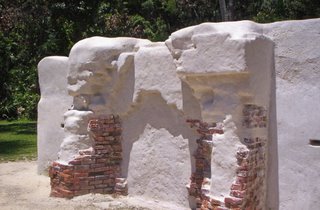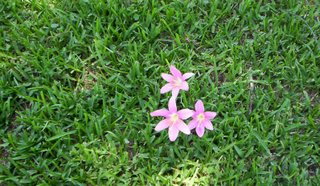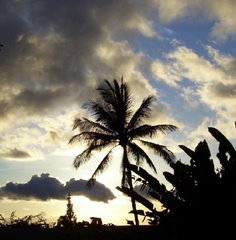Picking Cotton
What will the remains of our current civilization look like? What will the future inhabitants of this planet surmise about how we lived by picking through our remains?
It is hard for us to imagine how quickly time really moves and how abrupt change can be. One hundred and fourty one years ago things changed and a way of life was over for good. Thirty five years after that the growing fields that supported an old way of life were abandoned. The forest returned and hid the past from view. A mile long drive down a lime rock road through a thick dark Oak and Palmetto Palm forest ended at the waters edge to reveal a civilization from the not so distant past.
A sturdy cement hung on to be sure that everyone's voice was heard from further back than surface appearances would indicate.
Tabby is a material made primarily of oyster shells. It was collected from middens or piles, the remains left by the dietary and building habits of the Timucua people. This material was collected and used to construct the walls of houses for a certain class of people who lived and worked on this land.
A large semi-circle of small houses with two rooms were built. One room held the fireplace for the kitchen and a second much smaller room was for sleeping. I would imagine that other than those two activities not much time was spent in these huts. Most of their time was spent outdoors attending to the multitude of tasks required to survive. Their social lives were a communal affair, close to each other and open to view.
Several hundred yards away at the waters edge where the cool breeze could flow through, a house of a different class and different construction method was built.
Sea Island Cotton separated the two.
Rich man Poor man.
Like the head of the Sphinx looking out over Giza, this plaster restoration over the remains of a kitchen fireplace where thousands of meals were prepared seems to be saying, "Listen I have something to say."
A way of life that was unsustainable came to an end. A great moral disparity was too painful to endure forever. The natural processes that know time and its rhythms with much more intimacy came in to to heal the wounds and pretty up the place.
Zephyranthes grandiflora, a wonderful southern bulb bursts from the ground after a good hard rain.


4 comments:
Pink rain lilies? Or just rain lilies? I saw those flowers listed both ways when I looked it up... Also, if one is called the common name, is the other called the technical name?
Thanks for another universe-enlarging post, Christopher... the word 'tabby' now means something else than a pattern on a cat's fur, and you are making Florida, a place that was not on my must-see list, sound more intriguing than I'd thought.
When people that we know vacation in Florida, they always talk about going to Orlando, the movie studio rides or the beaches, not the historical sites. Maybe that's because most of them have kids in tow. If my husband & I ever get to Florida, we'll have to seek out places like Kingsley Plantation.
Chris & Christin, I have rainlilies, too, but not the Zephyranthes grandiflora. Mine are a paler variety called Zephyranthes 'Labuffarosea'. There's also a native white rainlily found here in Central Texas called Cooper's Lily, Cooperian pedunculata. I have some of that one, too.
M Sinclair Stevens over at the Zanthan Garden blogsite grows the same hot pink one shown in this post.
Christina, a common name like Rain Lily can vary from region to region generally or even from one gardener to another. I call them Zephyr Lilies myself. The other name is the latin or botanical name and is agreed upon by an international board of botanists who handle the nomenclature of plants. That way a plant is identifiable around the globe and in any language.
I was curious and looked up the Texas native white Rain Lily, Cooperia pedunculata that Annie mentioned and found that it had been renamed Zephyranthes drummondii, though the original latin/botanical name is still in common use. There is plenty of controversy involved in the plant naming world too.
I grow both Z. rosea a more diminuative and dark pink one that I found growing in Haleakala National Park and collected seed from and a larger very pale pink Z. grandiflora that I brought seed from the house where I grew up in Florida. So I wonder if it is the variety "Labuffarosea"?
Annie there is a lot to see in Florida other than Universal and Disney. It is a 10 hour drive from top to bottom.
Disney does have Cirqe de Solei (Sp?) and that is a must see if you don't see it in Vegas. Plus they both are horticultural extravaganzas. The gardens there are truly wonderful. I would like to see the zoological park one day. Tons of golf too if anyone is a golfer, so Orlando isn't just for kids.
There a tons of natural cool fresh water springs in Florida. One the Ichetucknee you can float down on an innertube and is much fun.
I wouldn't go to Florida between June 1st and November 1st. Mega hot and your whole trip could be cancelled by a hurricane.
The 'Labuffarosea' came six years ago from Tony Avent's wonderful Plant Delight's nursery - originally from Mexico. Thanks for the new name on the white rainlily. They grew wild at my last house, but didn't bloom because the deer kept eating them. They finally flowered after a few bulbs were transplanted into deck containers, which eventually came with us to this garden. No deer yet - maybe I should plant them in the ground.
Thank you for the travel notes, Christopher. I've bookmarked them in the event we ever get to Florida.
Post a Comment